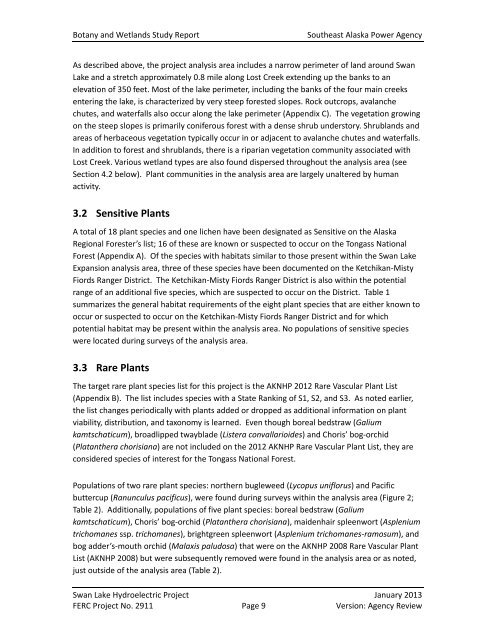Botany and Wetlands Study Report - McMillen, LLC
Botany and Wetlands Study Report - McMillen, LLC
Botany and Wetlands Study Report - McMillen, LLC
You also want an ePaper? Increase the reach of your titles
YUMPU automatically turns print PDFs into web optimized ePapers that Google loves.
<strong>Botany</strong> <strong>and</strong> Wetl<strong>and</strong>s <strong>Study</strong> <strong>Report</strong>Southeast Alaska Power AgencyAs described above, the project analysis area includes a narrow perimeter of l<strong>and</strong> around SwanLake <strong>and</strong> a stretch approximately 0.8 mile along Lost Creek extending up the banks to anelevation of 350 feet. Most of the lake perimeter, including the banks of the four main creeksentering the lake, is characterized by very steep forested slopes. Rock outcrops, avalanchechutes, <strong>and</strong> waterfalls also occur along the lake perimeter (Appendix C). The vegetation growingon the steep slopes is primarily coniferous forest with a dense shrub understory. Shrubl<strong>and</strong>s <strong>and</strong>areas of herbaceous vegetation typically occur in or adjacent to avalanche chutes <strong>and</strong> waterfalls.In addition to forest <strong>and</strong> shrubl<strong>and</strong>s, there is a riparian vegetation community associated withLost Creek. Various wetl<strong>and</strong> types are also found dispersed throughout the analysis area (seeSection 4.2 below). Plant communities in the analysis area are largely unaltered by humanactivity.3.2 Sensitive PlantsA total of 18 plant species <strong>and</strong> one lichen have been designated as Sensitive on the AlaskaRegional Forester’s list; 16 of these are known or suspected to occur on the Tongass NationalForest (Appendix A). Of the species with habitats similar to those present within the Swan LakeExpansion analysis area, three of these species have been documented on the Ketchikan‐MistyFiords Ranger District. The Ketchikan‐Misty Fiords Ranger District is also within the potentialrange of an additional five species, which are suspected to occur on the District. Table 1summarizes the general habitat requirements of the eight plant species that are either known tooccur or suspected to occur on the Ketchikan‐Misty Fiords Ranger District <strong>and</strong> for whichpotential habitat may be present within the analysis area. No populations of sensitive specieswere located during surveys of the analysis area.3.3 Rare PlantsThe target rare plant species list for this project is the AKNHP 2012 Rare Vascular Plant List(Appendix B). The list includes species with a State Ranking of S1, S2, <strong>and</strong> S3. As noted earlier,the list changes periodically with plants added or dropped as additional information on plantviability, distribution, <strong>and</strong> taxonomy is learned. Even though boreal bedstraw (Galiumkamtschaticum), broadlipped twayblade (Listera convallarioides) <strong>and</strong> Choris’ bog‐orchid(Platanthera chorisiana) are not included on the 2012 AKNHP Rare Vascular Plant List, they areconsidered species of interest for the Tongass National Forest.Populations of two rare plant species: northern bugleweed (Lycopus uniflorus) <strong>and</strong> Pacificbuttercup (Ranunculus pacificus), were found during surveys within the analysis area (Figure 2;Table 2). Additionally, populations of five plant species: boreal bedstraw (Galiumkamtschaticum), Choris’ bog‐orchid (Platanthera chorisiana), maidenhair spleenwort (Aspleniumtrichomanes ssp. trichomanes), brightgreen spleenwort (Asplenium trichomanes‐ramosum), <strong>and</strong>bog adder’s‐mouth orchid (Malaxis paludosa) that were on the AKNHP 2008 Rare Vascular PlantList (AKNHP 2008) but were subsequently removed were found in the analysis area or as noted,just outside of the analysis area (Table 2).Swan Lake Hydroelectric Project January 2013FERC Project No. 2911 Page 9 Version: Agency Review


